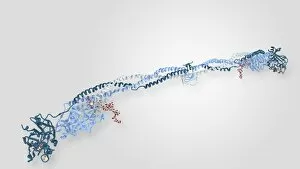Blood Plasma Collection
"Unconventional Oxygen Transport: The Fascinating World of Antarctic Icefish" In the icy depths of the Antarctic
All Professionally Made to Order for Quick Shipping
"Unconventional Oxygen Transport: The Fascinating World of Antarctic Icefish" In the icy depths of the Antarctic, a unique family of fish known as Channichthyidae defies conventional wisdom. Mackerel icefish, Champsocephalus gunnari, glide gracefully under the frozen surface, their bodies devoid of haemoglobin. Unlike other vertebrates, these remarkable creatures have evolved an alternative method to transport oxygen throughout their bodies. Blackfin icefish, Chaenocephalus aceratus, join in this mesmerizing underwater ballet. They too navigate effortlessly beneath the ice without relying on haemoglobin. Instead, they possess a secret weapon - blood plasma research has revealed that these fish utilize a specialized mechanism to carry life-sustaining oxygen. Ocellated icefish, Chionodraco rastrospinosus, find solace resting on the seabed under the frozen expanse above them. Their reliance on blood plasma for oxygenation sets them apart from their counterparts across different ecosystems and continents. Jonah's icefish Neopagetopsis ionah elegantly swims alongside its fellow Channichthyidae members beneath the icy canopy. These extraordinary creatures showcase nature's ingenuity by bypassing traditional means of oxygen transportation found in most vertebrates. With mouths agape like mackerel icefish Champsocephalus gunnari swimming below them; blackfin icefish Chaenocephalus aceratus explore every inch close to the seabed or venture further into uncharted territories under thick layers of freezing water. Their ability to thrive without haemoglobin highlights their exceptional adaptation skills and resilience in extreme environments. As scientists delve deeper into understanding this phenomenon through blood plasma research and unraveling intricate molecular structures like fibrinogen molecule C014/0473; they uncover nature's hidden secrets and gain insights into potential applications for human health. The world of Antarctic icefish is a testament to the wonders of evolution and adaptation.









